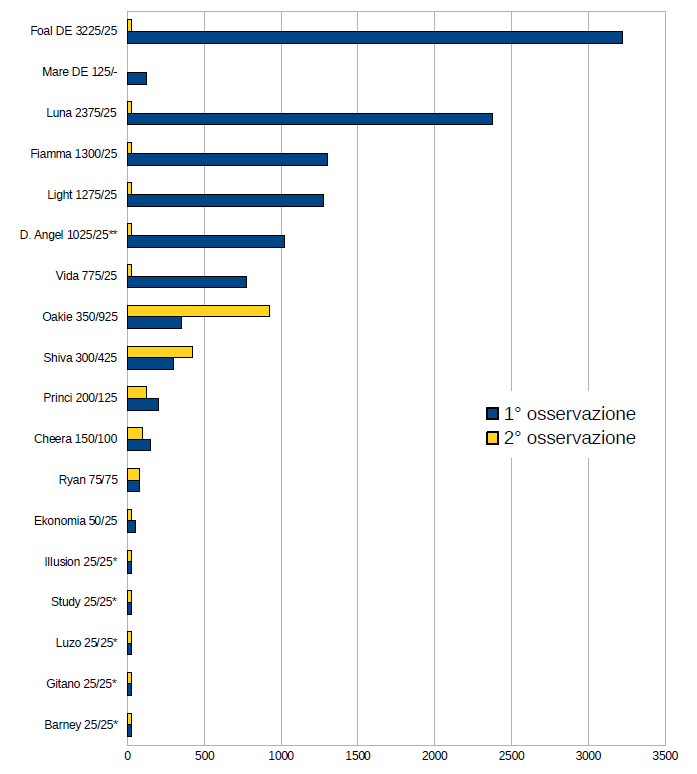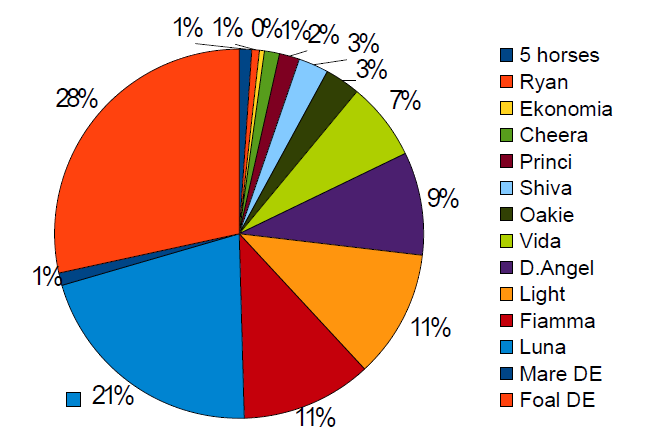La lettura di questo articolo dovrebbe essere preceduta da quella di : “A Parasitological Study of a Herd of Horses in Italy”
Parassiti- Ospiti !IN!desiderabili
I parassiti interni sono onnipresenti e una tegola che il cavallo deve sopportare ?
Comportano un qualche beneficio? Sono simbionti? Stimolano? Non credo. I cavalli rinselvatichiti sembrano più scarsamente parassitati. Cosa significa questo? E perchè? Come possiamo mettere in relazione mustang e domestico su questo? Cosa possiamo imparare?
Genetica – Selezione
I selvatici sono sottoposti alla pressione della selezione. I meno competitivi, e coloro che portano con sé una carica di parassiti lo sono certo meno, hanno più ridotte probabilità di sopravvivere nella carestia e di trasmettere alla discendenza il loro patrimonio genetico. I più fortunati invece vedono con la capacità di rispondere efficacemente all’infezione quella di riprodursi. Il territorio. L’ambiente vasto ed a vegetazione sparsa dell’areale colonizzato dai mustang fa si che gli animali ripassino dove hanno deposto feci e e con esse le uova dei parassiti difficilmente o dopo molto tempo. Con la siccità ed il caldo, non con il freddo e la neve, le larve raggiunto lo stadio infettante esauriscono presto le loro scorte alimentari e si disidratano. La temperatura alta accelera i processi metabolici. Poche settimane e muoiono. Durante l’inverno la maggiore scarsità di cibo fa si che gli animali si spostino e coprano grandi distanze. Anche se la vita del parassita allo stato larvale nel terreno si allunga, ammesso che l’uovo si schiuda, non incontrerà un cavallo. Durante l’estate gli animali sono più stanziali e rallentati dai puledri ma i parassiti sono sfavorevolmente colpiti dalla siccità e dal caldo che appunto accelera il loro metabolismo e li disidrata rapidamente. Il risultato è che gli eventuali parassiti adulti ospitati all’interno del cavallo, o asino, completato il loro ciclo di vita, non vengono rimpiazzati da altri sotto forma di uova o larve con il pascolo. I parassiti non si moltiplicano nell’ospite come invece fanno batteri e virus, hanno bisogno di un passaggio nell’ambiente esterno e a seconda dei casi di un ospite temporaneo.
Perchè invece il domestico è quasi sempre più infettato?
Il parassita e le verminosi pesanti sono quindi il risultato dell’antropizzazione, della scarsità di spazio a disposizione, della mancanza di selezione. Il carattere “ resistenza alle verminosi” come espressione di maggiore capacità del sistema immunitario non è tenuto in conto dagli allevatori che non ne conoscono nemmeno l’esistenza. Non credo, non è provato e fino a che non lo sarà è una invenzione di comodo che nel cavallo domestico i parassiti intestinali o dello stomaco o di altri sistemi svolgano una qualche positiva funzione. Semmai il loro sistema immunitario è continuamente stressato e distolto dal prepararsi e combattere contro altri obiettivi .
Il caso del cavallo domestico scarsissimamente infettato o che addirittura appare “vuoto” all’analisi?
All’osservazione di una bassissima carica di parassiti, o addirittura alla mancanza di uova nelle feci di alcuni cavalli, il 10% della popolazione nella mia esperienza, do due motivazioni : La prima, favorevole, sarebbe la particolare resistenza dell’individuo. La riscontro solitamente associata al generale stato di salute ed alla posizione dominante nel branco. I cavalli “vuoti” di Asvanara sono i dominanti. I cavalli “pieni” di Asvanara sono quelli che occupano una posizione bassa nella gerarchia. (leggete il rapporto sulla infezione del branco di Pieve S.Stefano) La seconda, molto meno desiderabile, è la scarsa condizione dell’individuo, spesso prossimo alla morte. Mi è capitato, ed è osservazione di altri tra cui l’amico vet. Cesare Ninassi, di osservare conte di uova pari a zero in animali deboli ed alla fine. Quasi che nemmeno i parassiti trovino conveniente un albergo di tal fatta.
In sostanza la verminosi non è auspicabile ma è comune risultato della esposizione in un ambiente dai confini limitati di un animale normalmente dotato ed in apparente buona salute.
Osservazione e controllo
L’osservazione e stima della verminosi necessita di strumenti, conoscenza e tempo.
E’ molto facile e comodo prescrivere farmaci più o meno adatti. Il cliente crede di avere provveduto, il farmacista ha venduto, il produttore prodotto, il prescrivente sollevato dalle responsabilità, il cavallo ha subito.
Una delle molte riconosciute cause di laminite è l’intossicazione. Il farmaco e la morte di milioni di adulti e di larve liberano una grande quantità di tossine che possono valicare la barriera dell’epitelio intestinale a causa delle stesse lesioni create dai parassiti. In questo i piccoli strongili sono i più aggressivi e per questo più dannosi e mortali. Si nutrono infatti del chimo ma anche dei tessuti e del sangue. I piccoli strongili sono nello stesso tempo quelli che hanno sviluppato maggiore resistenza nei confronti dei vari farmaci, in special modo più vecchi e da tempo utilizzati. Sono ubiquitari e parassitano animali di ogni età e condizione. Controllo delle verminosi vuol dire quindi oggi controllo degli strongili. Anche nei puledri, afflitti da ascaridi gli strongili sono presenti in quantità. L’utilizzo di farmaci non effettivi nei riguardi degli strongili significa selezione di ceppi resistenti fin dalla più tenera età quando in buona fede il proprietario ed il professionista sono concentrati sul pericolo ascaridi. Se un ceppo di strongili è resistente lo è anche a ripetuti assalti con farmaci poco efficienti, anzi ogni volta se ne favorisce maggiormente la selezione.
Cosa significa resistenza
Per resistenza si intende la capacità di sopravvivenza alla azione del farmaco. Un parassita nel suo ambiente è limitato dalla presenza degli altri. Se è resistente mentre molti intorno muoiono avrà poi vita più facile e maggior motivo e agio di moltiplicarsi. Il farmaco ha provveduto alla selezione del più adatto nella circostanza.
Utilizzare farmaci più datati, quelli di generazione precedente ai lattoni (ivermectina e suoi derivati), è corretto quando, tramite l’analisi, se ne ricerca e dimostra la persistente capacità abbattente. Per convenzione si ritiene efficace il farmaco capace di abbattere non meno del 98% degli adulti. Diversamente si continua nella selezione, sconsiderata e determinata dall’ignoranza, dei vermi del decennio, i ceppi dei piccoli strongili resistenti.
La presenza di soli strongili non resistenti nel nostro cavallo domestico attuale e quindi l’efficacia dei farmaci di vecchia generazione è ormai episodica e constatabile in enclave di animali isolati dal contatto con altri da molto tempo.
Poichè è già molto difficile che i cavalli vengano avviati ad una conta delle uova nelle feci (FEC) al fine di quantificarne l’infezione è velleitario credere nella diffusione capillare di tecniche di controllo e determinazione dell’infezione e della capacità abbattente del farmaco prima e dopo la sua somministrazione con il raddoppio dei costi.
L’uso del farmaco maggiormente efficace, l’ivermectina e suoi derivati, è quindi l’unica soluzione pratica proponibile salvo eccezione. Eccezione rappresentata dal proprietario che, sperando di essere fortunato e avendo un cavallo o gruppo di cavalli separato, desidera conservare l’efficacia del farmaco più “moderno” più a lungo.
Alcuni farmaci, delle varie classi, possono rimanere in vendita, nonostante la più ridotta efficacia, per inerzia o motivi commerciali. Fino a che c’è l’acquirente rimane l’offerta. Solo la manifesta grave dannosità ne determina l’abbandono. Nel caso dei farmaci antiparassitari la causa (il farmaco) e l’effetto (il danno) non possono essere facilmente associati. Specialmente se si tratta di resistenza.
Che fare?
– Possiamo verificare periodicamente lo stato dell’infezione tramite la analisi coprologica “quantitativa” Mc Muster grazie agli istituti di igiene e profilassi o presso il laboratorio di pochi professionisti, biologi o veterinari che siano, che conoscono la metodica e la sanno condurre.
– Tenendo presente che ogni animale ha il suo proprio livello di infezione e presto ritorna ai “numeri” precedenti se non cambiano le condizioni di gestione si decide poi se trattare o meno con un farmaco di ultima generazione. Ivermectina e /o derivati.
– L’uso di una associazione farmacologica consente di combattere al tempo l’infezione sia di vermi tondi che di piatti ( Ivermectina + Praziquantel ) , esempio commerciale è l’Equalan Duo. I vermi piatti non sono normalmente riscontrabili alla osservazione microscopica ma facilmente ci sono e sono evidenziati da altri tipi di analisi, antigene anticorpo, più cari e difficilmente attuabili in modo esteso e tale da soddisfare la massa.
– L’animale prostrato o il giovane puledro che si ritiene possa essere gravemente parassitato necessita di ulteriori cautele al fine di non incorrere in fatalità determinate dalla simultanea morte di un eccessivo numero di parassiti. E’ il caso degli ascaridi se presenti in grande numero che dovrebbero essere attaccati con dosi dimezzate più di una volta. E’ l’unico caso pratico. Quando si tratta di strongili utilizzare dosi ridotte favorisce l’insorgere di resistenza.
– Un cavallo laminitico cronico dovrebbe parimenti vedere valutata con rigore e conservativamente la somministrazione di qualsiasi farmaco.
L’IGIENE e la selezione sono determinanti. Come è poco coerente pensare di controllare l’infezione restando in un ambiente fortemente contaminato è auspicabile l’adozione delle basse letture FEC (fecal egg count) come condizione per l’avvio alla riproduzione. La rotazione dei campi, il pascolo associato con altri erbivori, lo spargimento di letame associato alla rimozione programmata per alcune settimane d’estate degli animali riduce l’esposizione alla reinfezione continua.
Il proprietario
Il proprietario consapevole ed avveduto ha un importante ruolo nel determinare l’orientamento professionale. La richiesta di maggiore specializzazione spinge all’aggiornamento e formazione di capacità di analisi. Analisi che soprattutto i gestori e allevatori di animali dovrebbero essere capaci di condurre in modo indipendente. Il mondo anglosassone e soprattutto americano anche in questo è avanti e non sono pochi coloro che realizzano un risparmio nell’acquisto dei farmaci associato alla migliore programmazione .
Le case farmaceutiche mentre con i loro settori commerciali continuano a proporre vecchie soluzioni tramite i loro settori ricerca stimolano ad uno utilizzo mirato alla conservazione dell’efficacia residuale dei più moderni farmaci limitando i trattamenti:
– agli animali che si ritiene siano in maggiore e seria necessità.
– utilizzando farmaci di comprovata efficacia nella situazione e caso
L’uso “a tappeto” di farmaci non conviene a nessuno e riproduce il dramma della resistenza agli antibiotici.
La metodica Mc Muster di analisi per la determinazione della carica infestante è facile da condurre. Sul sito bitlessandbarefoot sezione letture trovate pagine dedicate e letture consigliate. Prima fra tutte per semplicità e chiarezza “Bad Bugs” pubblicata su “The Horse”, che posso inviare a richiesta. Dodici articoli logici e conseguenti scritti da veterinari americani qualche anno fa. Pensati per il proprietario al fine di migliorare le condizioni degli animali e garantire loro un futuro meno…parassitato.




